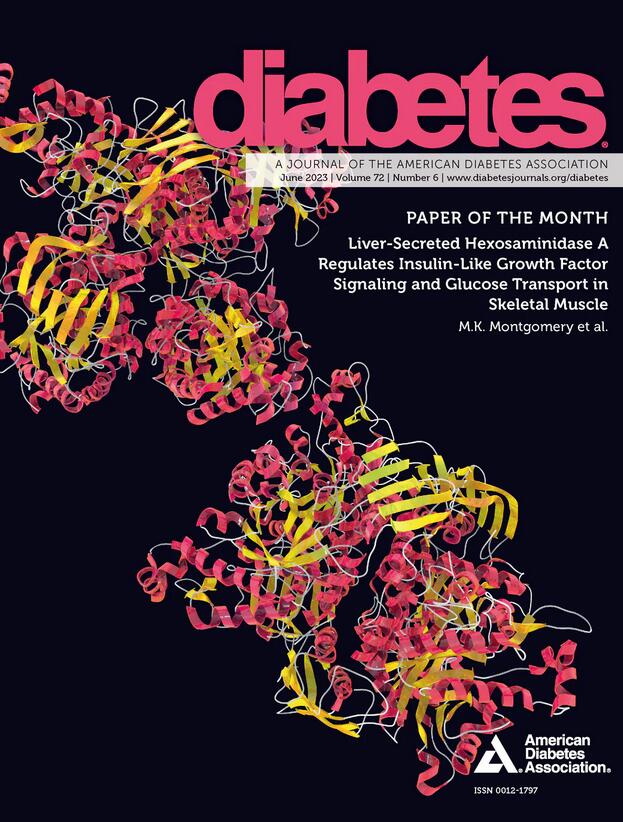Effect of Weight Loss on Skeletal Muscle Bioactive Lipids in People with Obesity and Type 2 Diabetes
IF 7.5
1区 医学
Q1 ENDOCRINOLOGY & METABOLISM
引用次数: 0
Abstract
Muscle sn-1,2-diacylglycerol (DAG) and C18:0 ceramide accumulation in sarcolemmal and mitochondrial compartments have been proposed to regulate muscle insulin sensitivity. Here, we evaluated whether weight loss-induced improvements in insulin sensitivity were associated with changes in muscle sn-1,2-DAG and ceramide content in people with obesity and type 2 diabetes. We measured skeletal muscle insulin sensitivity, assessed by using the hyperinsulinemic-euglycemic clamp procedure in conjunction with stable isotopically labeled glucose tracer infusion, and skeletal muscle sn-1,2-DAG and ceramide contents by using liquid chromatography-tandem mass spectrometry after subcellular fractionation and DAG isomer separation in 14 adults with obesity and type 2 diabetes before and after marked (18.6 ± 2.1%) weight loss. Whole-body insulin sensitivity doubled after weight loss. Sarcolemmal sn-1,2-DAG and C18:0 ceramide contents after weight loss were not different than values before weight loss. In contrast, mitochondrial/ER C18:0 ceramide content decreased by ∼20% after weight loss (from 2.16 ± 0.08 to 1.71 ± 0.13 nmol/g, P<0.005). These results suggest a decrease in muscle mitochondrial/ER C18:0 ceramide content could contribute to the beneficial effect of weight loss on skeletal muscle insulin sensitivity.减肥对肥胖症和 2 型糖尿病患者骨骼肌生物活性脂质的影响
肌肉sn-1,2-二乙酰甘油(DAG)和C18:0神经酰胺在肌浆膜和线粒体中的积累被认为可以调节肌肉的胰岛素敏感性。在此,我们评估了减肥引起的胰岛素敏感性改善是否与肥胖和 2 型糖尿病患者肌肉中 sn-1,2-DAG 和神经酰胺含量的变化有关。我们采用高胰岛素血糖钳夹法和稳定同位素标记的葡萄糖示踪剂输注法评估了 14 名肥胖症和 2 型糖尿病成人的骨骼肌胰岛素敏感性,并在体重明显减轻(18.6 ± 2.1%)前后,通过亚细胞分馏和 DAG 异构体分离后的液相色谱-串联质谱法测量了骨骼肌 sn-1,2-DAG 和神经酰胺的含量。体重减轻后,全身胰岛素敏感性增加了一倍。体重减轻后,肉泡膜sn-1,2-DAG和C18:0神经酰胺的含量与体重减轻前的数值没有差异。相反,减肥后线粒体/ER C18:0 神经酰胺含量下降了 20%(从 2.16 ± 0.08 降至 1.71 ± 0.13 nmol/g,P<0.005)。这些结果表明,肌肉线粒体/ER C18:0神经酰胺含量的减少可能是减肥对骨骼肌胰岛素敏感性产生有益影响的原因。
本文章由计算机程序翻译,如有差异,请以英文原文为准。
求助全文
约1分钟内获得全文
求助全文
来源期刊

Diabetes
医学-内分泌学与代谢
CiteScore
12.50
自引率
2.60%
发文量
1968
审稿时长
1 months
期刊介绍:
Diabetes is a scientific journal that publishes original research exploring the physiological and pathophysiological aspects of diabetes mellitus. We encourage submissions of manuscripts pertaining to laboratory, animal, or human research, covering a wide range of topics. Our primary focus is on investigative reports investigating various aspects such as the development and progression of diabetes, along with its associated complications. We also welcome studies delving into normal and pathological pancreatic islet function and intermediary metabolism, as well as exploring the mechanisms of drug and hormone action from a pharmacological perspective. Additionally, we encourage submissions that delve into the biochemical and molecular aspects of both normal and abnormal biological processes.
However, it is important to note that we do not publish studies relating to diabetes education or the application of accepted therapeutic and diagnostic approaches to patients with diabetes mellitus. Our aim is to provide a platform for research that contributes to advancing our understanding of the underlying mechanisms and processes of diabetes.
 求助内容:
求助内容: 应助结果提醒方式:
应助结果提醒方式:


